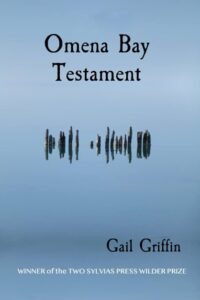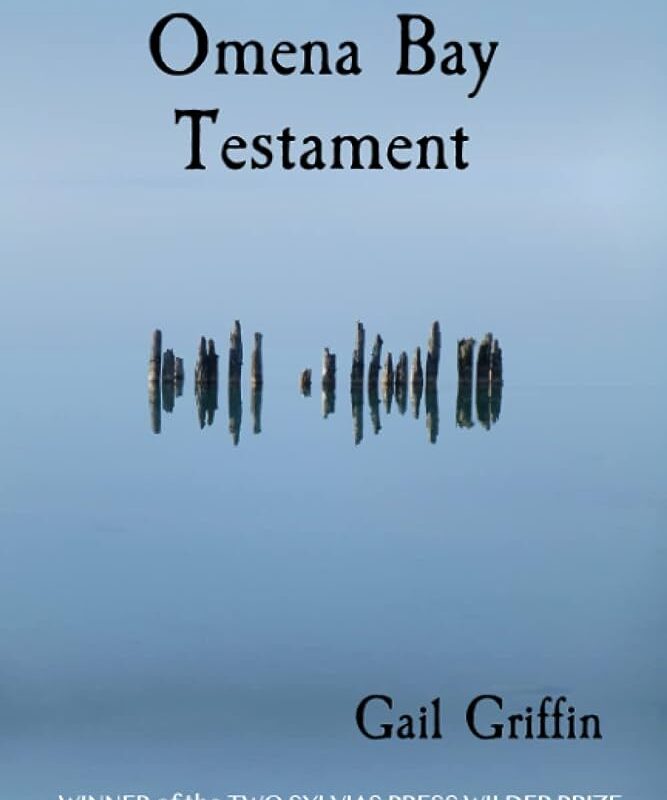 Michiganders are well-aware—and perhaps a little begrudging—that every summer, without fail, the northern parts of the lower peninsula and much of the state’s west coast buzz with new life. In the Wolverine state, we share Grand Traverse County and Leelanau County with seasonal tourists—out-of-state visitors hoping to scale Sleeping Bear Dunes, sample wine in Traverse City, or spend a week huddled up next to Lake Michigan. Nestled within this idyllic landscape, Omena Bay is a small, mystical cove that curves into the Leelanau Peninsula. If you’re using the geography of your left hand to describe the lower peninsula, it’s the bay that curves alluringly into Michigan’s little finger. Omena Bay is a destination within a destination; it also sits at the heart of writer Gail Griffin’s new poetry collection, Omena Bay Testament.
Michiganders are well-aware—and perhaps a little begrudging—that every summer, without fail, the northern parts of the lower peninsula and much of the state’s west coast buzz with new life. In the Wolverine state, we share Grand Traverse County and Leelanau County with seasonal tourists—out-of-state visitors hoping to scale Sleeping Bear Dunes, sample wine in Traverse City, or spend a week huddled up next to Lake Michigan. Nestled within this idyllic landscape, Omena Bay is a small, mystical cove that curves into the Leelanau Peninsula. If you’re using the geography of your left hand to describe the lower peninsula, it’s the bay that curves alluringly into Michigan’s little finger. Omena Bay is a destination within a destination; it also sits at the heart of writer Gail Griffin’s new poetry collection, Omena Bay Testament.
Winner of the 2022 Two Sylvias Press’s prestigious Wilder Series Poetry Book Prize, Omena Bay Testament is Griffin’s debut full-length collection. Named after Sylvia Plath and bookseller Sylvia Beach, Two Sylvias Press, located in Washington, aims to highlight exceptional voices of literary talent and annually honors a writer over 50 (who identifies as a woman) with the Wilder Prize. Griffin, a Detroit native and current Kalamazoo resident, is the author of four nonfiction books, including “The Events of October”: Murder-suicide on a Small Campus, and Grief’s Country: A Memoir in Pieces. As I picked up Omena Bay Testament at Michigan News Agency in downtown Kalamazoo, I was struck by the book’s cover—an arresting portrait of the still-water bay (courtesy of Bill Betts). It’s difficult to differentiate the horizon from the blue sky. The back cover of the book mirrors the front. The poems in this book live within this limitless beauty.
Omena Bay Testament is a book of fifty-five pieces divided into four named sections, each carrying a poem of the same title. These contemporary pieces range in form and theme and consider events of history such as the terrorist attacks of 9/11 (“Marquette, Tuesday, September 11, 2001”) and a reflection of the Covid-19 pandemic (“2020 Vision”). These poems cover love and grief, loss and wonder. The first section, This Edge, is largely about aging, loss, and mortality as a woman. The second (The End of Wildness) is about childhood, youth, and innocence, while the third section (Toward Water) contains a series of poems on loss and grief. Lastly, the fourth section (Parable of the Mountain Lion) meditates on the fear and anxiety we live in now, as well as violence and dehumanization. Many of the poems in this collection were previously published in places like The Southern Review, Third Coast, Fourth Genre, Great Lakes Review, The Michigan Poet, New Delta Review, The Prose Poem, Folio, and others.
The poem “Omena Bay Testament” invites the reader into section one and into the collection as a whole with a rather memorable line: “Truth be told, I’ve probably fucked my last.” The poem moves the reader on to the beauty of the bay: the kayaks, the sailboats, the low and broken skies. “The bay / curves like a hand closing on something fragile,” the poem asserts (1). Yet this poem lets us know that the collection is thinking about more than just geography: loss, memory, and grief all sit at the heart of this book from the word go. From the title poem, the pieces in (This Edge) move us through the O’Connor home in Milledgeville, Georgia to a prospective MRI to a speaker’s brother cleaning out his garage on his 79th birthday to “Still Life with Crow”: “Sometimes she felt a rising in her throat. / Sometimes she felt the weight of air / displaced by shiny, tar-black wings” (9). Whenever a crow shows up in a poem, I tend to pay attention; these beautiful birds are always harbingers of something else. Alongside the crow, a starling appears several times throughout the collection, popping its head up on occasion (as in the poem “sternus vulgaris”) as though to remind us where—and who—we are. Water also plays a significant role in unifying these poems. Unsurprisingly, water draws these pieces together as much as the water in Omena Bay keeps bodies of land apart.
Like the first section, in section two,water and the seasons play important roles in the lives of these lingering poems. Griffin’s poems take on a variety of forms: couplets, when intimate, long stanzas when meditative, as in the poem “The End of Wildness” and “Basement,” Section two is also where we encounter the first of several triptych pieces “Oval.” In these, each section (Rabbit Egg, Fractured Skull, and Silly Putty) explores a facet of a unified idea. I found myself unprepared for the emotional resonance in the long poem, “Memento Mori,” a meditation on a child’s place in a family. Directly after that poem, the reader encounters the section’s titular poem, “The End of Wildness” and its cascading lines on a childhood spent in “empty lots with hip-high weeds” and “brown belly-pods full of white silk.” (pg 25). Several more triptych-style pieces follow in this section, including “The Facts of Life,” which is also about starlings, and “Transcript,” which is thinking about the History of England. From the gorgeous poem, “Facts of Life”: “Slowly I learn to tell them apart,” the speaker says. “…The martins, compact, scarce, not purple at / all but velvety dark blue; and the starlings, long and loud, flat back flashing / brown green.” The choice to name each section of the triptych pieces provides additional layers of meaning to the poem, making it all the richer for reading. And while the majority of the poems in this collection are startling and haunting, others seem content to delight in more of life’s levity, such as the poem, “When Andrea Graddis Pierced Her Ears.”
Section three of Omena Bay Testament moves us “Toward Water”—although in Michigan, and particularly by a bay, we are never not thinking about water. The poem tells the story of saving a turtle from the roadside, yet like all of Griffin’s pieces, hints at a meaning much deeper. “The Bride Wore Black” also appears in Griffin’s memoir, which was recognized by the Library of Michigan as a Michigan Notable Book in 2020. s The lines are so memorable: “Who was she kidding, moving around the room, / dazed and footsore in those shoes, failing to see his eyes, / him in the dark suit, waiting for her to be done with this, / the man standing quiet as a cyclone’s eye, slowly disappearing?” In the memoir, the poem “The Bride Wore Black” creates strong emotional resonance in its place in Griffin’s personal story. In Omena Bay Testament, I found the poem just as engaging in its subtle subversion of how weddings typically function in our collective imagination. Just Night, Just Dark,” the poem that follows directly after “The Bride Wore Black” emphasizes that sense of loss so skillfully explicated within the pages of, Grief’s Country. To complete the arc, Griffin includes the poem based on a prompt by Maura Stanton, “Write a poem in the voice of a widow whose husband has drowned.” Wow. Also impressive to me is the poem, “I came back to the life I was assigned,” which allows the title to operate as a first line, concluding the sentence, “and locked the door behind me.”
Lastly, in section four,the reader encounters a number of poems stemming from real life headlines and events, such as the section’s first poem, “Man Held in Burning of Homeless Woman in Los Angeles” and “The Auschwitz Photographer.” Poems grounded this way, to me, become particularly illuminated through the lens of history. Lines from “Lupercale,” which takes an epigraph from the Kalamazoo Gazette are hauntingly beautiful: “The light returns to us this time each year. / The sun keeps faith, whatever name we choose / to give it, more reliable than gods / or emperor.” Throughout the book, but particularly in this final section, Griffin takes a variety of source material for epigraphs which create a powerful and lasting effect. Other epigraph sources include the Bible’s Old Testament (in “Eve, an Apologia”), Euripedes, Democritus, Ralph Waldo Emerson, Wicked, the book of Acts (in “Pentecost”), and newspaper articles, both local to Michigan and national. Griffin’s poems often return to stories—testaments—from the Bible, either directly or in allusive ways. Many of these poems are thinking about Adam, thinking about Eve, or thinking about Noah on his ark. Indeed, the book closes on the poem, “Rainbow,” leaving us with the flood, and the fish that had no need for sanctuary: “But what salvation could they use?” the poem asks. “Why should they care if it’s / fire next time, the fish, with nothing to forget or to remember? The fish, / who cannot close their eyes.”
This book is gorgeous and rich. It’s one I predict I will return to time and time again—just like those tourists from other states who want to borrow Michigan’s beauty when the weather is at its finest. There’s much meaning packed in these dense lines, much to revel in its images and metaphors. These poems make me feel like I’ve traveled to Omena Bay myself, though I never have. Perhaps this fall after the lasts of the tourists have departed, turned their cars and vans and RVs for their home states, I too can make my way to these waters, wade in their depths, take in their astounding gifts one by one, just as I took in the poems in Griffin’s remarkable collection.
Colleen Alles
Colleen Alles is a native Michigander and Michigan girl for life. She hopes for poems with memorable emotional arcs, fiction that thoughtfully explores daily life, and any writing that invites the reader to sit down next to the author and have a beer. Or coffee. Among her favorite writers are Richard Ford, Joan Didion, Elena Ferrante, and Mary Oliver; Jane Eyre is her desert island book. Colleen works as a Developmental Editor and is—safe to say, at this point—obsessed with her dog. You can find her on her website.
